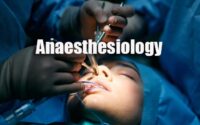Orthopaedics Practice Set
Orthopaedics Practice Set paper for the written examination is given below. Candidates who are looking for Orthopaedics exam Practice Set paper can find in this section. The applied candidates who are getting prepared for the Orthopaedics can view this page for the Orthopaedics Last Ten Years Practice Set Papers.

Download the Orthopaedics Practice Set & Solutions & make it as a reference for your exam preparation. Take advantage of these Orthopaedics Practice Set Papers in a proper manner to get qualifying Marks. Last 5 years Orthopaedics Practice Set Papers provided here. Candidates who are applied for the above exam can check and download the Orthopaedics Practice Set Papers from here.
Practice Set of Orthopaedics
1. A patient has a swollen, tendon hindfoot with focal tenderness beneath the heel after falling 12 feet. Radiographs and CT scans are negative. An MRI scan would most likely reveal. which of the following conditions?
(1) Occult subcortical fracture of the calcaneus
(2) Acute osteonecrosis
(3) Rupture of the posterior tibial tendon
(4) Rupture of the plantar fascia
2. A 22-month-old girl has cerebral palsy. Which of the following findings is a good prognostic indicator of the child’s ability to walk in the future?
(1) Asymmetric tonic neck reflex
(2) Moro reflex
(3) Extensor thrust
(4) Positive parachute reaction
3. Hypothyroidism is most commonly associated with which of the following paediatric conditions?
(1) Legg Calve Perthes
(2) Slipped capital femoral epiphysis
(3) Toxic synovitis
(4) Achondroplasia
4. Sprengel deformity is associated with all, EXCEPT –
(1) Dextrocardia
(2) Klippel — Feil syndrome
(3) Congenital scoliosis
(4) Diastematomyelia
5. A genetic abnormality in the cyclic AMP signalling pathway is involved in which of the following conditions?
(1) Achondroplasia
(2) Hypochondroplasia
(3) Multiple hereditary exostosis
(4) Fibrous dysplasia
6. Dwarfism caused by a defect of Fibroblast Growth Factor Receptor — 3 (FGFR3) is associated with all of the following traits, EXCEPT –
(1) Rhizomelic limb shortening
(2) Normal intelligence
(3) Frontal bossing
(4) Cervical spine instability
7. Which of the following conditions is inherited in an X — linked dominant fusion?
(1) Hemophilia A
(2) Marfan syndrome
(3) Familial hypophosphatemic rickets
(4) Sickle cell anemia
8. All of the following are described procedures for CTEV, EXCEPT –
(1) Dwyer Osteotomy
(2) Akron Dome Osteotomy
(3) Lichtblau Procedure
(4) Dillwyn — Evans Procedure
9. In Nail-patelia syndrome, the patella is –
(1) High lying pateila
(2) low lying patella
(3) Small or absent
(4) Large
10. Which is false about radiological features in DDH?
(1) Acetabular index increases
(2) Centre edge angle decreases
(3) Alpha angle decreases (measured on USG)
(4) Beta angle decreases (measured on USG )
11. Ponseti method of clubfoot cast treatment starts with which of the following steps?
(1) Pronation of forefoot
(2) Dorsiflexion of the ankle
(3) Dorsiflexion of first ray
(4) Internal rotation of foot
12. A 13-year-old boy has a left slipped capital femoral epiphysis which has displaced 75%. He is unable to bear weight on the limb, other hip is normal. Your preferred treatment is as follows –
(1) Hip spica cast
(2) Gentle reduction of the slip and fixation with cannulated screw
(3) Free vascularized fibular grafting
(4) Subtrochanteric osteotomy
13. Which of the following is associated with a mutation in the GNAS gene?
(1) Fibrosarcoma
(2) Chondroblastoma
(3) Fibrous dysplasia
(4) Osteoblastoma
14. Which of the following is not a typical deformity/gait disturbance seen in cerebral palsy?
(1) Toe walking
(2) Wide-based gait
(3) Hip adduction
(4) Forearm supination
15. Trethowan’s sign is seen in –
(1) Transient synovitis hip
(2) Perthes disease
(3) SCFE
(4) Coxa vara
16. Features of Klippel — Feil Syndrome include all, EXCEPT –
(1) Fusion of 2 or more cervical vertebrae
(2) Low hairline at the back of head
(3) Short Neck
(4) Webbed Fingers
17. Most common site of Actinomycosis amongst the following is –
(1) Cervicofacial
(2) Foot
(3) Rib
(4) Tibial metaphysis
18. First Neurological sign in TB of thoracic spines is –
(1) Motor involvement
(2) Sensory loss
(3) Bowel/ Bladder involvement
(4) Increased deep tendon reflexes
19. All are associated with chronic osteomyelitis, EXCEPT –
(1) Sequestrum
(2) Amyloidosis
(3) Myositis ossificans
(4) Metastatic abscesses
20. Tuberculous arthritis of knee in advanced cases leads to –
(1) Charcot joints
(2) Bony ankylosis
(3) Fibrous ankylosis
(4) Subluxation with internal rotation of tibia
| Practice Set | MCQs |
| Quiz | Questions and Answers |
21. Felon is –
(1) Infection of nail fold
(2) Infection of pulp space
(3) Infection of thenar space
(4) Infection of Midpalmar space
22. A 72-year-old who underwent a total knee replacement 6 weeks ago presents with increasing knee pain and swelling, with raised inflammatory markers. An aspiration of the joint cultures coagulase-negative staphylococcus. The next most appropriate step in management is –
(1) Single-stage revision plus intravenous antibiotics.
(2) Two-stage revision, with cement spacer plus intravenous antibiotics.
(3) Intravenous antibiotics.
(4) Open washout/debridement, polyethylene exchange and intravenous antibiotics.
23. Which of the following is not a component of Kocher’s criteria when diagnosing septic arthritis of the hip?
(1) Non-weight-bearing on the affected side
(2) Erythrocyte Sedimentation Rate (ESR) greater than 40 mm/hr
(3) Fever
(4) White Blood Cell (WBC) count of > 12000 mm3
24. Which of the following inflammatory mediators has been most closely associated with the magnitude of the inflammatory response to blunt trauma and with the development of Multiple Organ Dysfunction Syndrome (MODS)?
(1) Interleukin – I (IL-1).
(2) Beta-Human Chorionic Gonadotropin (β-HCG).
(3) Tumour Necrosis Factor-beta (TGF- β).
(4) Interleukin – 6 (IL-6).
25. A 3-year-old African — American child presents with irritability, fever and a warm, swollen leg. Imaging shows an area concerning for osteomyelitis and transcortical biopsy reveals multiple Salmonella species. This child most likely also has which of the following conditions?
(1) Osteogenesis imperfecta
(2) Child abuse
(3) Thalassemia
(4) Sickle cell anemia
26. Most common type of Tuberculosis in spine is –
(1) Appendiceal
(2) Anterior
(3) Central
(4) Paradiscal
27. ‘Caries sicca’ is seen in –
(1) Shoulder
(2) Spine
(3) Wrist
(4) Hip
28. Kanavel’s sign is positive in –
(1) Tenosynovitis
(2) Trigger Finger
(3) Dupuytren’s contracture
(4) Carpal Tunnel Syndrome
29. Tom Smith’s arthritis manifests as –
(1) Lengthening of limb
(2) Hip Stiffness
(3) Ankylosis
(4) Hip instability
30. The most common organism causing osteomyelitis in drug abusers is –
(1) Staphylococcus
(2) Klebsiella
(3) E-coli
(4) Pseudomonas
31. Coronary Ligament of knee connects –
(1) Two anterior horns of menisci
(2) Two posterior horns of menisci
(3) Menisci and Tibial condyle
(4) Menisci and collateral ligaments
32. Which of the following ligament prevents hyperextension of the hip?
(1) Iliofemoral ligament
(2) Ischiofemoral ligament
(3) Pubofemoral ligament
(4) Ligamentum teres
33. Which of the following is not a prerequisite of gait?
(1) Foot prepositioning
(2) Stability instance
(3) Adequate stride length
(4) Conservation of energy
34. Finkelstein test is used for diagnosis of –
(1) Carpal Tunnel Syndrome
(2) Thoracic Outlet Syndrome
(3) De Quervain’s Tenosynovitis
(4) Cervical Myelopathy
35. Bouchard’s nodes are seen in –
(1) Knee Joints
(2) Wrist Joints
(3) Proximal Interphalyngeal Joints
(4) Distal Interphalyngeal Joints
36. Which of the following incorrectly describes changes in articular cartilage?
(1) Water content increases in osteoarthritis.
(2) Water content decreases as part of ageing.
(3) Young’s modulus of elasticity increases in ageing.
(4) Chondrocyte number increases in ageing.
37. 32-year-old man presents with a 2 month history of back and right-sided leg pain. He walked with right sided Trendelenburg gait. The most likely diagnosis is-
(1) An ipsilateral paracentral disc herniation at L3 – L4.
(2) An ipsilateral paracentral disc herniation at L5 – S1.
(3) An ipsilateral far lateral disc herniation at L4 – L5.
(4) An ipsilateral far lateral disc herniation at L5 – S1.
38. Which of the following is true regarding Superior Mesenteric Artery (SMA) syndrome?
(1) The condition often occurs in overweight female patients.
(2) This syndrome is also known as cast syndrome.
(3) The condition occurs following curve correction as a result of an increase in the angle between the aorta and the superior mesenteric artery.
(4) The condition is due to an ischemic event of the SMA.
39. All of the following contribute to the wrist and hand deformity in rheumatoid arthritis, EXCEPT-
(1) Volar subluxation of the Extensor Carpi Ulnaris (ECU).
(2) Radioscaphocapitate ligament failure.
(3) Scaphoid extension.
(4) Supination of the carpus on the forearm.
40. Motor supply of axillary nerve is –
(1) Supraspinatus
(2) Subscapularis
(3) Infraspinatus
(4) Teres minor
41. Nerve entrapped in arcade of Frohse –
(1) Medial Nerve
(2) Ulnar Nerve
(3) Radial Nerve
(4) PIN
42. Bisphosphonates are used for all, EXCEPT –
(1) Osteosclerosis
(2) Osteoporosis
(3) Osteolytic bone metastasis
(4) Paget’s disease
43. A 35-year-old female presents with darkening of urine on standing, joint pain and stiffness and pigment deposition in joints. What is most probable diagnosis?
(1) Phenylketonuria
(2) Alkaptonuria
(3) Gout
(4) Tyrosinemia
44. Which of the following antibiotics is bacteriostatic at therapeutic serum concentrations?
(1) Penicillin
(2) Cefoxitin
(3) Clindamycin
(4) Vancomycin
45. Titanium, an extremely reactive metal is one of the most biocompatible implant material because –
(1) Nothing in the biologic environment reacts with titanium.
(2) Physiologic condition inhibit titanium reactions.
(3) Protein coat the titanium and insulate it from the body.
(4) Titanium spontaneously forms a stable oxide coating.



